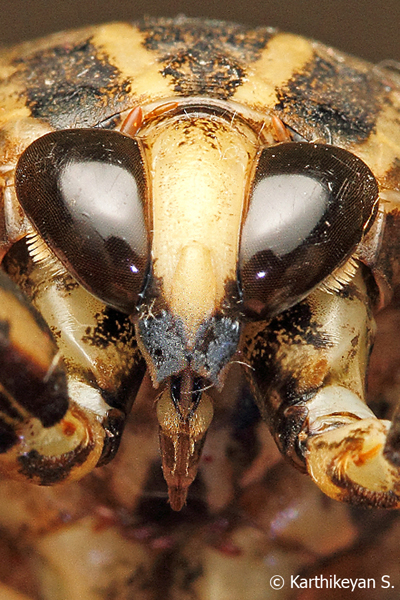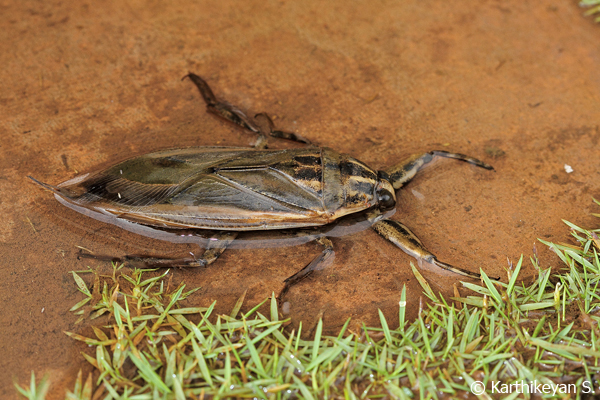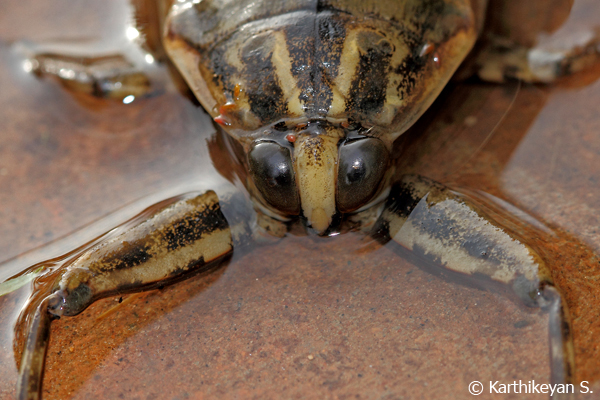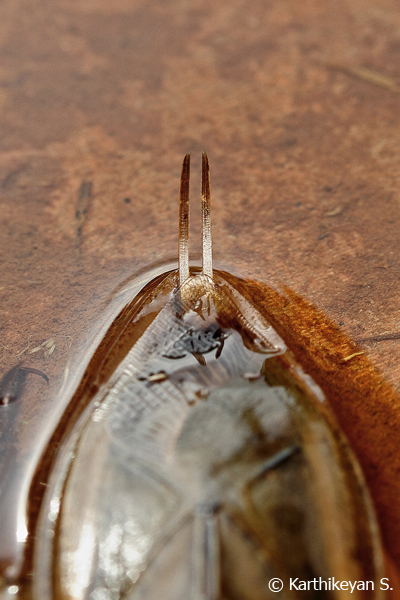After an incessant deluge throughout the afternoon, there was a lull. The sky was still covered with nimbostratus and it was threatening to rain again. This was one of the wettest Novembers that I had experienced in Bangalore. It was around 6pm; the streetlights were already glowing. Armed with an umbrella, I decided to go out for a walk and also get a few routine chores done. For the most part, the walk was uneventful. I looked at the vegetation that was drenched – the avenue trees, the climbers and creepers growing on compounds, little herbs growing all along the footpath. The crowns and leaves of the huge Rain trees were drooping as did the crowns of several others. The water weighed them down – they looked wet and happy.
Having ticked off things on the To Do list, I was heading back. I was barely 100 m. from home when I noticed something unusual on the road below a streetlight. As I approached it and bent down to get a closer look, I seemed to recognize what I was staring at. A Giant Water Bug!
The creature was about 2 inches long and was lying on its backside. I tentatively touched it. It didn’t move. Was it dead or was it feigning dead? I picked it up carefully (it is known to give a painful bite with its hard and stiff rostrum) to examine it.

There was still no movement; it was still. Perhaps, the bug got attracted to the street light, hit the light and fell down, or perhaps, got hit by a vehicle as it was flying towards the light. Either way, I could not see any visible injuries.
At this juncture, I felt a heavy drop of water fall on my balding head. This was an indication that the clouds were going to resume from where they had left. So, with bug in hand, I ran across the road into a sheltered place and then reached home before the rains became heavy again. I was still not sure if the creature I was holding was dead or alive. So, I set it aside briefly until I could make suitable arrangements for the bug. I found a small pot with soil, placed it in a bucket and filled the bucket with water until it reached the rim of the pot. This done, I placed the bug in the pot. This way, it could get into water or choose to stay dry if it were still alive.
I admired at how the bug was so beautifully adapted to an aquatic lifestyle. The body was flat, sleek and streamlined; it had hind legs that were somewhat flat enabling it to swim in the water.

Giant Water Bug Lethocerus sp.
The forelimbs were robust and muscular and aided the insect in grasping small prey animals.

Muscular forelimbs.
During the night, I tried reading up about the Giant Water Bug. I was fascinated to learn that this bug family (Family Belastomatidae) contains the largest of all bugs and they are known to be aggressive predators. They use their rostrum to bite the prey and inject digestive saliva. Later they suck the prey dry – very like the Assassin Bugs. Even more interesting is the parental care exhibited by some species of this family. The females lay eggs on the back of the male and he carries it around until they hatch!
The next morning, I checked on the bug. I was pleased with what I saw. The insect had chosen to ‘come to life’ and had gotten into the water filled bucket. The manner in which it was suspended in water was a surprise to me – the hind quarters was sticking out! Thoughts of another creature, the water scorpion which uses its tail to breathe came to my mind. And I quickly figured that the Giant Water Bug too was doing exactly that. As it sensed disturbance, it quickly went to the bottom of the bucket only to resurface after a while and stick its hind end out of water while the body was still submerged – a bug’s version of a snorkel!
I wanted to release the bug in a suitable place. And I wanted to shoot pictures too! Armed with the camera, I took the bug to a nearby water puddle and set it down in shallow water. It stayed still for a couple of minutes. During this brief window of time I saw something remarkable. The bug put out two tube like organs above the surface of water every now and then! Apart from some pictures of the whole insect, I also managed to get pictures of the breathing apparatus before the creature moved into deeper water amid vegetation.

I shared the pictures of this encounter with L.Shyamal. He informed me that this species (Lethocerus sp.) does not exhibit the parental behaviour explained above. Also, that these bugs are sold in many markets in the Far East where they are consumed as a delicacy.
The next time you happen to visit a water body, look around for one of these giant bugs. If you spot one, do take some time to stand by and watch. It can be really fun watching them come to surface to breathe from time to time!